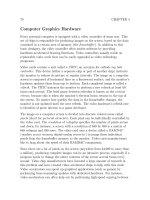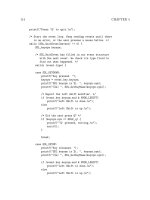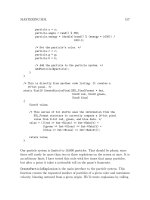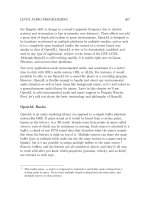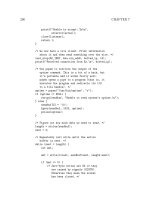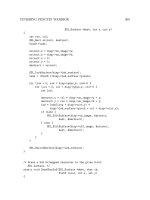Programming Linux Games phần 10 pot
Bạn đang xem bản rút gọn của tài liệu. Xem và tải ngay bản đầy đủ của tài liệu tại đây (278.45 KB, 47 trang )
FINISHING PENGUIN WARRIOR 369
SDL_Surface *dest, int x, int y)
{
int row, col;
SDL_Rect srcrect, destrect;
Uint8 *leds;
srcrect.w = disp->on_image->w;
srcrect.h = disp->on_image->h;
srcrect.x = 0;
srcrect.y = 0;
destrect = srcrect;
SDL_LockSurface(disp->led_surface);
leds = (Uint8 *)disp->led_surface->pixels;
for (row = 0; row < disp->phys_h; row++) {
for (col = 0; col < disp->phys_w; col++) {
int led;
destrect.x = col * disp->on_image->w + x;
destrect.y = row * disp->on_image->h + y;
led = leds[(row + disp->virt_y) *
disp->led_surface->pitch + col + disp->virt_x];
if (led) {
SDL_BlitSurface(disp->on_image, &srcrect,
dest, &destrect);
} else {
SDL_BlitSurface(disp->off_image, &srcrect,
dest, &destrect);
}
}
}
SDL_UnlockSurface(disp->led_surface);
}
/* Draws a 5x5 bitmapped character to the given 8-bit
SDL surface. */
static void DrawChar5x5(SDL_Surface *dest, char ch,
Uint8 color, int x, int y)
{
370 CHAPTER 9
char *data;
Uint8 *pixels;
int sx, sy;
data = Font5x5[(int)ch];
if (SDL_MUSTLOCK(dest))
SDL_LockSurface(dest);
pixels = (Uint8 *)dest->pixels;
for (sy = 0; sy < 5; sy++) {
for (sx = 0; sx < 5; sx++) {
if (data[5*sy+sx] != ’ ’) {
pixels[dest->pitch*(y+sy)+x+sx] = color;
} else {
pixels[dest->pitch*(y+sy)+x+sx] = 0;
}
}
}
SDL_UnlockSurface(dest);
}
/* =====================================
End of LED stuff.
Back to the world of Penguin Warrior.
===================================== */
/* A temporary buffer for the characters currently on the display. */
#define SCROLLER_BUF_SIZE 10
char scroller_buf[SCROLLER_BUF_SIZE];
/* Message to scroll. This can be changed. */
const char *scroller_msg = "Welcome to Penguin Warrior";
int scroller_pos = 0;
int scroller_ticks = 0;
/* Various LED displays that appear on the Penguin Warrior screen. */
LED_Display player_score, player_shields, player_charge;
LED_Display opponent_score, opponent_shields;
LED_Display status_msg;
FINISHING PENGUIN WARRIOR 371
int InitStatusDisplay(void)
{
if (LED_CreateDisplay(&player_score, 12, 5, 12, 5,
"led-red-on.bmp", "led-red-off.bmp") < 0)
return -1;
if (LED_CreateDisplay(&player_shields, 12, 1, 12, 1,
"led-red-on.bmp", "led-red-off.bmp") < 0)
return -1;
if (LED_CreateDisplay(&player_charge, 80, 1, 80, 1,
"led-red-on.bmp", "led-red-off.bmp") < 0)
return -1;
if (LED_CreateDisplay(&opponent_score, 12, 5, 12, 5,
"led-red-on.bmp", "led-red-off.bmp") < 0)
return -1;
if (LED_CreateDisplay(&opponent_shields, 12, 1, 12, 1,
"led-red-on.bmp", "led-red-off.bmp") < 0)
return -1;
if (LED_CreateDisplay(&status_msg, 56, 5, 66, 5,
"led-green-on.bmp", "led-green-off.bmp") < 0)
return -1;
memset(scroller_buf, 0, SCROLLER_BUF_SIZE);
return 0;
}
void CleanupStatusDisplay(void)
{
LED_FreeDisplay(&player_score);
LED_FreeDisplay(&player_shields);
LED_FreeDisplay(&player_charge);
LED_FreeDisplay(&opponent_score);
LED_FreeDisplay(&opponent_shields);
LED_FreeDisplay(&status_msg);
}
void SetStatusMessage(const char *msg)
372 CHAPTER 9
{
scroller_pos = 0;
scroller_msg = msg;
}
void SetPlayerStatusInfo(int score, int shields, int charge)
{
char buf[3];
Uint8 *pixels;
int i;
/* Set the score counter. */
sprintf(buf, "%2i", score);
DrawChar5x5(player_score.led_surface, buf[0], 1, 0, 0);
DrawChar5x5(player_score.led_surface, buf[1], 1, 6, 0);
/* Set the shield bar. */
SDL_LockSurface(player_shields.led_surface);
pixels = (Uint8 *)player_shields.led_surface->pixels;
for (i = 0; i < 12; i++) {
if (i < shields * 12 / 100)
pixels[i] = 1;
else
pixels[i] = 0;
}
SDL_UnlockSurface(player_shields.led_surface);
/* Set the phaser charge bar. */
SDL_LockSurface(player_charge.led_surface);
pixels = (Uint8 *)player_charge.led_surface->pixels;
for (i = 0; i < 80; i++) {
if (i < charge * 80 / PHASER_CHARGE_MAX)
pixels[i] = 1;
else
pixels[i] = 0;
}
SDL_UnlockSurface(player_charge.led_surface);
}
void SetOpponentStatusInfo(int score, int shields)
FINISHING PENGUIN WARRIOR 373
{
char buf[3];
Uint8 *pixels;
int i;
/* Set the score counter. */
sprintf(buf, "%2i", score);
DrawChar5x5(opponent_score.led_surface, buf[0], 1, 0, 0);
DrawChar5x5(opponent_score.led_surface, buf[1], 1, 6, 0);
/* Set the shield bar. */
SDL_LockSurface(opponent_shields.led_surface);
pixels = (Uint8 *)opponent_shields.led_surface->pixels;
for (i = 0; i < 12; i++) {
if (i < shields * 12 / 100)
pixels[i] = 1;
else
pixels[i] = 0;
}
SDL_UnlockSurface(opponent_shields.led_surface);
}
void UpdateStatusDisplay(SDL_Surface *screen)
{
int i;
/* Update the scroller.
This is not linked to the global time_scale, since speed
really doesn’t matter. The only effect of a high framerate
would be that the scrolling message would move faster. */
if ((scroller_ticks % 6) == 0) {
char ch;
for (i = 0; i < SCROLLER_BUF_SIZE-1; i++) {
scroller_buf[i] = scroller_buf[i+1];
}
if (scroller_msg[scroller_pos] == ’\0’) {
ch = ’ ’;
scroller_pos ;
} else {
ch = scroller_msg[scroller_pos];
}
374 CHAPTER 9
scroller_pos++;
scroller_buf[i] = ch;
status_msg.virt_x = 0;
for (i = 0; i < SCROLLER_BUF_SIZE; i++) {
DrawChar5x5(status_msg.led_surface, scroller_buf[i],
1, 6 * i, 0);
}
} else {
status_msg.virt_x++;
}
scroller_ticks++;
LED_DrawDisplay(&player_score, screen, 0, 0);
LED_DrawDisplay(&player_shields, screen, 0, 48);
LED_DrawDisplay(&player_charge, screen, 0, 471);
LED_DrawDisplay(&opponent_score, screen, 544, 0);
LED_DrawDisplay(&opponent_shields, screen, 544, 48);
LED_DrawDisplay(&status_msg, screen, 96, 0);
}
status.c is divided into two parts. The first part implements the LED simulator
described earlier, and the second part uses the simulator to create game status
displays for Penguin Warrior. Penguin Warrior’s status display consists of six
pieces: a scoreboard and shield block for each player, a scrolling message banner,
and a phaser charge readout for the local player. Each piece has its own
LED Display structure.
To use the status display system, the game engine calls InitStatusDisplay at
startup and then executes UpdateStatusDisplay during each frame. Whenever
a game statistic (score, shield level, or phaser charge) changes, the game calls
SetPlayerStatusInfo or SetOpponentStatusInfo to update the information.
It can set new banner messages with SetStatusMessage. The LED simulator
redraws the boards at each frame. Although alpha-blended blits are relatively
slow, this update is negligible in comparison to the rest of the game loop. Figure
9–3 shows the new status display system.
Penguin Warrior is complete, at long last! It’s a relatively small game, but it
contains all of the major ingredients you’d find in a larger production, and the
engine performs reasonably well. The next section discusses some of the things I
FINISHING PENGUIN WARRIOR 375
Figure 9–3: Penguin Warrior’s status display
could have done differently throughout the project.
In Retrospect
I created Penguin Warrior to demonstrate game programming in the Linux
environment. I started writing it while I was trying to decide where to go with
Chapter 4, and I’ve added features throughout the book to demonstrate various
topics that came up. There was no formal design process, other than the
planning that went into the book as a whole. Penguin Warrior turned out well
enough, but it’s an incredibly simple game compared to most. At the risk of
hypocrisy, I strongly recommend that you put considerable thought into the
design of your games. It’s easy to write games that look good; it’s much harder
to write games that play well. Admittedly, Penguin Warrior doesn’t have much
depth.
376 CHAPTER 9
What could I have done differently? Here are a few things that come to mind.
• I could have used C++ instead of C. C++ lends itself well to game
programming, since games usually simulate interactions between physical
objects to some extent. In fact, any object-oriented programming language
would be beneficial in that regard. There are plenty of arguments for and
against C++, and it’s the topic of many mailing list holy wars.
• Penguin Warrior would benefit from a more sophisticated networking
system. The current TCP-based system, in which the clients take turns
exchanging packets, is simple, but its performance is highly dependent
upon the quality of the underlying network. A UDP-based protocol would
be more complex to implement, but it could potentially offer better
performance.
• In hindsight, Tcl was not an especially good choice for the scripting engine.
It works in this case, but it’s not a very good solution for number
crunching or managing large amounts of data. If I were to rewrite Chapter
6, I would probably choose a Lisp variant such as Scheme.
• Resource management is always a challenge. The present implementation
of Penguin Warrior uses an ad hoc resource-loading routine, but this task
could be performed in a more general and flexible way. Each resource (a
sound clip or a graphic) could have a symbolic name, and the resource
manager could load them on demand.
• The source tree would be much easier to build if it had a GNU Autoconf
script. As it stands, you usually need to tweak the makefile to build the
game. While this is fine for developers, it might be confusing for end users.
There are also some gameplay features that would make nice additions to
Penguin Warrior (and perhaps good weekend projects for interested readers):
• More weapons. Many games allow the player to pick up “power-ups” from
the playing field. Perhaps Penguin Warrior could have floating Power
Penguins for the players to find.
• A radar screen for tracking the opponent. Alpha blending could add a nice
effect to such a display.
FINISHING PENGUIN WARRIOR 377
• The ability to have two scripted opponents play each other over the
network. This would be useless but fun to watch.
That’s it for Penguin Warrior. The next chapter talks about the various Linux
distributions and package managers you have to contend with, as well as
FreeBSD portability. It also discusses the Loki Setup tool, a program for
installing games in a distribution-independent way.
Chapter 10
To Every Man a Linux
Distribution
You’ve probably noticed that there are a lot of Linux distributions floating
around the Internet. Some of these are major commercial operations (Red Hat,
SuSE, Caldera), some are massive community efforts (Debian), and some don’t
really fit into either category (my personal favorite, Slackware). Competition is
good, but this assortment sometimes leads to incompatibilities between
distributions, which you’ll have to contend with when you release your work to
the public.
Once your game is ready to see the light of day, you’ll need to come up with a
way for users to install it. This could be as simple as a .tar.gz archive (tarball)
containing your game’s source code and data files, or it could be as complex as a
CD-ROM-based graphical setup system. Whatever you decide to do, you’d be
well advised to respect the Linux filesystem standard and account for the
differences between various Linux distributions. If you don’t, you’ll irritate users
at the very least and possibly cause serious problems. On the brighter side, a
well-packaged program can make a good first impression.
380 CHAPTER 10
Source or Binary?
The first decision you’ll have to make is whether you want to release the source
code to your game. Generally speaking, it’s a nice thing to do, and it’s more or
less a requirement if you’re using libraries covered under the GNU General
Public License.
1
Releasing the source code to your project means that bugs will
probably turn up much more quickly (since everyone will be able to pitch in and
help you track them down), and other programmers will have the opportunity to
learn from your code. Linux exists because of its open source development
model, and many Linux advocates feel strongly about open versus closed source.
For various viewpoints on free software, open source software, and the rationale
of each, refer to the Free Software Foundation
2
and the Open Source Initiative
3
.
Sometimes it’s either impossible or impractical to release the code to a project.
For instance, nondisclosure agreements, publishing contracts, and game engine
licenses might prevent you from making a project’s code available to the public.
In this case you’ll have to settle for a binary distribution of your game.
Unfortunately, in doing so, you’ll probably alienate a certain number of
hard-core open source and free software advocates.
Binary-only distribution is possible, but you’ll have to give a bit of thought to
preparing the binary files. Binary distribution under Linux is a bit different than
binary distribution under Windows (where source distribution is almost unheard
of). With source distribution, a user can adjust the game to work well on a
particular machine (and can modify the game to his or her liking), but binary
releases are generally one-size-fits-all. Since various Linux distributions ship with
different versions of basic supporting software (in particular the C library), a
given binary might not get along with some systems.
4
1
The GNU GPL is much stricter in this sense than the LGPL. See for
more information on these licenses. SDL is released under the LGPL, which can be used in
closed games, under certain conditions.
2
3
4
Microsoft Windows has the same problem. Most application vendors fix this by shipping
basic system libraries (the MFC runtime, the Visual Basic library, and the Visual C++
runtime in particular) with each copy of the application. You’re likely to find several copies
of the same library on any given Windows system, and Windows users sometimes run into
TO EVERY MAN A LINUX DISTRIBUTION 381
Local Configuration
As we’ve said, each Linux distribution is slightly different, with its own ideas
about how the Linux filesystem standard should be implemented (more on this
later), and with a slightly different etc/ directory tree. In addition, users are
generally given a choice of which libraries and other supporting packages to
install, meaning that you can’t count on the presence of any particular
development library. For these reasons, getting a large program to compile and
link correctly on a given Linux installation can be quite a challenge.
There are several ways to approach this problem. Some developers opt to specify
local configuration options directly in a project’s makefile. For instance, the
following lines might show up in a makefile for an OpenGL-based project:
# Configuration section
CC= gcc
CFLAGS= -O2 -W -Wall -pedantic
X11LIBS= -L/usr/X11R6/lib -lX11 -lXt -lXext
GLLIBS= -lGL -lGLU -lglut
# End of configuration.
This is a bit of a hack, but it’s sufficient in some cases. All of the necessary
libraries are listed in an easy-to-find spot in the makefile, so that a user can
quickly configure the project to compile on his or her system. The program
would presumably come with a README file explaining how to do this. Users
who don’t know anything about makefiles, C, or programming in general might
find this solution a bit intimidating, however.
A better option is the GNU Autoconf facility. Autoconf is a sophisticated set of
m4 scripts
5
that automatically configure source trees for compilation on a variety
of systems. Based on information in Makefile.am files throughout a source tree,
Autoconf (more specifically the Automake program) generates a script called
problems with incorrect library versions.
5
m4 is a very simple but powerful macro language that people seem to either love or hate.
382 CHAPTER 10
configure that will configure the project’s makefiles to correctly build and
install everything for the current system. Ideally, Autoconf-enabled programs are
very easy to install, with a sequence of commands like the following:
$ tar xvfz fooblaster-1.1.tar.gz
$ cd fooblaster-1.1
$ ./configure
$ make
$ make install
If you’ve ever installed software on a Linux system, this probably looks familiar.
Of course this example is just meant to illustrate how convenient Autoconf can
be—it’s probably a bad idea to install a program blindly without reading the
docs (or without typing ./configure help to get a list of configuration
options).
What exactly does this black box of a script do? You may have noticed that
Autoconf-enabled source trees are full of files called Makefile.in. The
configure script first gathers information about the local system, and then goes
through the source directory and converts these files into final makefiles for the
project. As it copies each Makefile.in to a corresponding Makefile, configure
adds a bunch of environment variables that describe the system, as well as
special preprocessor symbols that C programs can use for customization. A
simple invocation of the Make utility can then build the fully configured
program. It’s worth noting that you should never need to alter a configure
script by hand; the proper way to make changes is to edit Makefile.am and
generate a new script.
Autoconf can be fairly complex to set up, and we’ll leave a discussion of its
specifics to other sources. Learning Autoconf is definitely worth the effort if you
plan to make a large source tree available to your users.
TO EVERY MAN A LINUX DISTRIBUTION 383
Linux Isn’t Alone: Supporting FreeBSD
Linux isn’t the only contender in the free OS arena.
6
FreeBSD is a very similar
system with an active and knowledgeable user community. Although FreeBSD
can theoretically run Linux binaries out of the box, a few differences sometimes
prevent Linux applications (and games) from working. Aside from these minor
glitches, FreeBSD is rather easy to support (and certainly worthwhile, given its
userbase), so it’s a good idea to keep a few things in mind as you develop:
• Half of the work in supporting FreeBSD is getting your build environment
set up. This should be easy: almost all Linux libraries are also available
under FreeBSD, as well as all of the familiar GNU development utilities.
Once you get your application to compile under FreeBSD, the rest is a
piece of cake. This is a good reason to use Autoconf; with a bit of help
from the configure script, there’s a good chance that your project will
require no modifications whatsoever for FreeBSD.
Note that the GNU Make utility is called gmake under FreeBSD. The
Make utility distributed with FreeBSD is actually BSD Make, which is
somewhat incompatible with GNU Make. If you plan to use Autoconf, you
definitely want GNU Make.
• FreeBSD’s filesystem is very similar to a typical Linux distribution’s
filesystem, and you should treat it accordingly. We’ll discuss filesystem
politeness later in this chapter.
• As a descendent of the original BSD, FreeBSD has no proc/ filesystem
(which the Linux kernel uses to publish live information about the system).
You probably shouldn’t mess with proc/ in most cases (since its exact
layout depends on the current version of the kernel), but it’s sometimes the
only sane way to get statistics about the system. If your program depends
on proc/, you’ll probably have to do some porting.
6
Although I speak of Linux here as a complete operating system, the more correct term
would be “Linux-based system,” or as the Free Software Foundation would prefer,
“Linux-based GNU system.” FreeBSD is the whole shabang—that is, unlike Linux,
FreeBSD encompasses a complete operating system, including a kernel and a set of software.
There is only one FreeBSD distribution, coordinated by a well-defined team of volunteers.
384 CHAPTER 10
• FreeBSD has no /etc/mtab file (which normally contains a list of
currently mounted filesystems). This discrepancy broke Loki Software’s
CD-ROM detection code when we tried to port it from Linux to FreeBSD.
I fixed it with a quick hack based on the output of the mount program, but
another programmer later found out that FreeBSD has a convenient
system call for retrieving the same information.
• FreeBSD has a completely different kernel than Linux. Slight internal
differences might cause quirky behavior when you run your newly ported
program. For instance, networking, memory mapping (mmap), and thread
scheduling might behave differently, since these functions are closely tied
into the kernel. These usually aren’t show-stopping issues, but it’s a good
idea to test your application thoroughly if you intend to officially support
FreeBSD.
• Unfortunately, FreeBSD currently has no framebuffer device interface. Of
course this won’t matter if your application uses an abstraction layer such
as SDL, but programs that require the Linux framebuffer interface are out
of luck. However, FreeBSD does support the Direct Rendering
Infrastructure, a lightning-fast 3D driver system originally created for
Linux.
Several other free UNIX-like operating systems (particularly NetBSD and
OpenBSD) are available, and it is nice to support these as well. You’ll have to
decide how much development time and energy you want to spend on porting
your work. If you’re developing free software, other people will probably help
you with this job. Everyone likes to see new software for his or her favorite
operating system, and porting a substantial chunk of code to a new platform can
be very satisfying.
Packaging Systems
A simple tarball of source code is probably the easiest way to distribute a Linux
application or game, and this is perfectly acceptable in some cases (especially if
the project takes advantage of Autoconf). However, source tarballs have several
disadvantages:
TO EVERY MAN A LINUX DISTRIBUTION 385
• Although they’re developer-friendly, source tarballs aren’t exactly
newbie-friendly. New Linux users often aren’t comfortable with building
and installing software from source. (They’ll probably want to learn how to
do this eventually, of course; it really isn’t too difficult.)
• Some systems aren’t meant to be developer workstations and therefore
don’t have the necessary compilers and libraries to build a source tree.
• A lot of people just want to download and install software without having
to compile anything. In addition to the time it takes to build a project from
source, binary distributions are often smaller than source distributions.
For these and other reasons, many Linux developers make precompiled packages
of their software available. Each Linux distribution has its own idea of what
exactly constitutes a “package,” and so developers often choose just one or two
major distributions to support. The two most commonly supported package
types are Red Hat’s RPM and Debian’s DEB. Neither of these are specific to
their “parent” Linux distributions; SuSE, Caldera, and TurboLinux are
RPM-based, and Debian’s packaging system has found its way into Corel Linux
and Storm Linux (which are actually Debian offshoots).
Package systems provide a bit of extra functionality over source tarballs.
Package managers can usually install a package with a single command (in the
case of RPM, the command rpm -i package.rpm does everything), they keep
track of all files that were installed so that they can be removed later, and they
can facilitate version upgrades. Most importantly, package managers can help
enforce dependencies. If your game needs version 1.1.6 or later of the SDL
library, for instance, a package manager will make sure that the system has it
before allowing the user to install the game.
If you want to learn how to make your own RPM packages, take a look at the
book Maximum RPM by Edward C. Bailey. (This book is also available in its
entirety online at RPM is not a simple tool
by any means, but, like Autoconf, it’s worth learning if you intend to maintain
complicated Linux software packages. Debian packages are even a bit trickier to
386 CHAPTER 10
roll than RPMs, but they are explained in detail on the Debian project’s
developer Web site
7
.
Making Slackware Packages
Unlike RPM and Debian packages, packages for Slackware Linux are
quite easy to create. To make a Slackware package, install your program
into a fake root. (For instance, copy files into tmp/foobar/usr/bin/
instead of usr/bin/.) All of your program’s installable files should be
there, but nothing else; there’s no need to duplicate anything not
related to your program. Make sure that the permissions on each file
are correct and that all symbolic links are in place. When the fake root
tree is ready to go, run the makepkg script (included with Slackware) to
create a .tgz package that can be installed with Slackware’s installpkg
script. .tgz packages are really just tarballs with a bit of extra
information; you can even install them manually (but that’s a bad idea).
Users really appreciate it when you take the time to create packages for their
favorite distribution—it can save them a lot of work and help them keep their
systems organized. However, maintaining packages does take a bit of work. If
you have to choose just one package type to support, it should probably be
RPM. If you’d like to maintain packages for a particular distribution, but don’t
have the time to do so, just ask around online. Chances are good that someone
enjoys making packages for that distribution and wouldn’t mind lending a hand.
As a closing thought, I’d like to point out that it is a very bad idea to release
your software in .rpm or .deb packages without providing a simple .tar.gz
option as well; many users (myself included) prefer to avoid package managers
entirely and install everything by hand.
7
/>TO EVERY MAN A LINUX DISTRIBUTION 387
Graphical Installation Goodness: Loki’s Setup
Program
Packages and tarballs are the staples of open source and free software
distribution, but they might not meet your needs. Off-the-shelf, boxed software
generally includes a nice, graphical installation program that copies the software
from its CD-ROM to the user’s hard drive and performs various setup tasks.
This would be easy to accomplish with a simple shell script, but it wouldn’t be
pretty (the Linux version of Maple, an excellent computer-assisted mathematics
system, uses a shell script for installation, and it is indeed ugly). A badly
written installation script could leave a first-time player with a bad impression of
the game as a whole, and the game industry is far too competitive for us to let
that happen.
Loki Software, Inc. developed Loki Setup to satisfy its need for a simple,
consistent, and portable installation system. Setup reads a product-specific
installation script from an XML file and then presents the user with a
GTK-based installation wizard. If X11 isn’t available, Setup provides an
equivalent terminal-based interface. Setup can check disk space, copy files, run
scripts, and launch the newly installed application when everything is finished.
Loki Setup is free software, released under the GNU GPL. (And since the Setup
program is separate from the software it installs, you can still use Loki Setup for
nonfree software without being affected by the GPL.)
To understand how to use Setup for a CD-ROM title, let’s take a look at Loki’s
Heavy Gear II CD. This is a major commercial title, originally written for
Windows but later ported to Linux. We’ll start with the top-level directory:
./autorun.inf
./binaries.tar.gz
./data.tar.gz
./icon.bmp
./icon.xpm
./README
./setup.sh
setup.sh is a shell script that invokes the appropriate setup binary for the
system’s architecture. These binaries are located in subdirectories of
388 CHAPTER 10
setup.data, which we’ll examine in a moment. The script locates the correct
subdirectory with the output of the uname -m command. autorun.inf is a
Windows autorun file to deal with users who mistakenly try to install this Linux
game on a Windows machine. The various icons and tarballs are game-specific.
And now the bin/ directory:
./bin
./bin/x86
./bin/x86/glibc-2.1
./bin/x86/glibc-2.1/hg2
./bin/x86/glibc-2.1/libMesaMatroxGL.so.3.2.000121
./bin/x86/glibc-2.1/libMesaVoodooGL.so.1.2.030300
./bin/x86/glibc-2.1/libMesaVoodooGL.so.1.2.030100
This directory contains the x86 binary for Heavy Gear II, as well as precompiled
OpenGL drivers for Matrox and 3Dfx graphics cards. Since Linux OpenGL
support is changing rapidly, it’s a good idea to include a working copy of the
appropriate drivers with any packaged game, in case the next release of the
drivers doesn’t work correctly. (3D graphics support under Linux is expected to
stabilize a bit in the near future as the DRI becomes the new standard, but now
is a rough time for 3D graphics in Linux.)
Next is the setup.data/ directory, where Setup gets most of its information:
./setup.data
./setup.data/bin
./setup.data/bin/alpha
./setup.data/bin/alpha/glibc-2.1
./setup.data/bin/alpha/glibc-2.1/setup.gtk
./setup.data/bin/alpha/setup
./setup.data/bin/ppc
./setup.data/bin/ppc/glibc-2.1
./setup.data/bin/ppc/glibc-2.1/setup.gtk
./setup.data/bin/ppc/setup
./setup.data/bin/sparc64
./setup.data/bin/sparc64/glibc-2.1
./setup.data/bin/sparc64/glibc-2.1/setup.gtk
./setup.data/bin/sparc64/setup
./setup.data/bin/x86
TO EVERY MAN A LINUX DISTRIBUTION 389
./setup.data/bin/x86/glibc-2.1
./setup.data/bin/x86/glibc-2.1/setup.gtk
./setup.data/bin/x86/setup
./setup.data/linkGL.sh
./setup.data/setup.glade
./setup.data/setup.xml
./setup.data/splash.xpm
This directory tree contains Setup binaries for four different architectures, with
both GTK- and terminal-based interfaces. The GTK binary requires GNU libc
2.1 or later, and so it’s placed in its own directory. The setup.sh script will run
this binary only if glibc 2.1 is available. The plain terminal-based version is
statically linked, and setup.sh will run it regardless of the system’s C library
version. setup.glade is a Glade GUI template for the Setup wizard,
splash.xpm is a version of the Heavy Gear II logo for the setup screen, and
setup.xml is the XML installation script.
The rest of the CD consists of Heavy Gear II’s datafiles and cinematics. Setup
just copies these files to the selected installation directory (probably
usr/local/games/hg2/), according to the setup.xml script.
setup.xml is pretty simple. XML may be overhyped, but this script is actually
a good use of the language.
8
Here’s the Heavy Gear II installation script:
<?xml version="1.0" standalone="yes"?>
<install product="hg2" desc="Heavy Gear II" version="1.0"
readme="README" postinstall="sh setup.data/linkGL.sh $*">
<option install="true" help="Required for play"
arch="x86" libc="glibc-2.1">
Base Install
<binary arch="any" libc="any" symlink="hg2"
icon="icon.xpm" name="Heavy Gear II">
hg2
</binary>
8
Don’t worry, you don’t need to know much about XML to use Setup. You can just copy an
existing script and tweak it for your particular application. If you’ve ever written Web pages
or documentation in HTML or SGML, XML’s syntax should look quite familiar.
390 CHAPTER 10
<files>
data.tar.gz
binaries.tar.gz
icon.bmp
icon.xpm
README
</files>
</option>
<option install="true">
GL Drivers (STRONGLY recommended)
<option>
3dfx Voodoo Mesa 3.2 GL library
<binary arch="any" libc="any">
libMesaVoodooGL.so.1.2.030100
</binary>
</option>
<option>
3dfx Voodoo Mesa 3.3 GL library
<binary arch="any" libc="any">
libMesaVoodooGL.so.1.2.030300
</binary>
</option>
<option>
Matrox G200/G400 Mesa 3.2 GL library
<binary arch="any" libc="any">
libMesaMatroxGL.so.3.2.000121
</binary>
</option>
</option>
<option>
Movies
<files>
shell/movies/asteroid.mpg
shell/movies/flight.mpg
shell/movies/gate.mpg
shell/movies/intro.mpg
(more MPEG movies)
shell/movies/sc37.mpg
shell/movies/sc3j.mpg
shell/movies/title.mpg
TO EVERY MAN A LINUX DISTRIBUTION 391
</files>
</option>
</install>
The root element of this XML file is labeled install, and it contains the options
needed for the complete installation process. Flags to the install section
include the name of the product, its version number, a brief description, the
name of an information file (in this case README), and a shell script to run
after the files have been copied to the user’s hard drive. You can optionally
include a preinstall script (to be executed before copying files), a default
installation path other than /usr/local/games, preuninstall and
postuninstall scripts for uninstalling the product (by default, Setup will just
remove the directory tree it installed), and several other flags (documented in
the Setup source package).
install usually contains several option elements. These elements specify sets
of files that may be installed. If an option node contains the install="true"
attribute, Setup will install it by default. You can nest option sections to
specify logical groups of files. If the user unchecks an option, Setup will block
out any nested options. You can also specify libc or architecture requirements
for options, making it easy to release a CD with support for several different
architectures. Setup also provides support for internationalization.
After the user selects the appropriate sets of files and clicks the Begin Install
button, Setup performs the following tasks:
1. Runs the preinstall script, if any (none in this case).
2. Creates the installation directory, in this case usr/local/games/hg2/.
Obviously, the user must have write access to this part of the filesystem;
Setup will refuse to continue otherwise.
3. Copies the selected file sets from the CD-ROM to the installation directory.
4. Writes an uninstall script in the installation directory. This script simply
removes all of the files that were copied and provides a quick way to
uninstall the software. The script also executes any requested
preuninstall or postuninstall scripts that were specified in setup.xml.
392 CHAPTER 10
Figure 10–1: Loki Setup in action
5. Runs the postinstall script, if any.
6. Offers the user a chance to view the README file, if one was given in
setup.xml.
7. Offers to run the program immediately.
Although Setup was designed primarily for CD-ROM titles, you could easily
make it work in other situations, as long as it can find the files it needs. You can
get your own copy of Loki Setup at Loki’s Web site
9
. The Setup package
includes source code as well as full documentation for the XML script format.
9
TO EVERY MAN A LINUX DISTRIBUTION 393
Understanding the Linux Filesystem Standard
Linux evolved from Linus Torvald’s pet project into a full-blown multiuser
operating system, and its filesystem has gone through a long period of evolution.
A while back people decided that it wouldn’t do for each Linux distribution to
use a different filesystem, and so an effort was made to settle on a standard.
Originally dubbed the Linux Filesystem Standard, this document has grown into
the Filesystem Hierarchy Standard (FHS), and it is meant to apply to all
UNIX-like operating systems. Most Linux distributions do a fairly decent job of
adhering to the FHS, which makes life easier for application (and game)
programmers who would like to support as many systems as possible.
We won’t duplicate the FHS here; it’s pretty long, and you can browse the whole
thing at We’ll simply offer a brief overview of
the filesystem and then give a few hints about where your game should put its
files. Following these hints will keep your users happy and hopefully reduce the
possibility of your game damaging someone’s filesystem. We’ll start with an
overview of the top-level directories on a typical Linux box.
10
/ The top-level directory. Don’t put anything here.
11
bin/ Important binaries that the system needs to boot. Don’t touch
this directory unless you have a really good reason (which is
unlikely if your product is a game).
boot/ The Linux kernel and various bootloader information.
dev/ Device files, such as dsp. You may need to access some of these,
but it’s unlikely that you’ll need to modify them.
etc/ Systemwide configuration files. Game configuration files almost
certainly do not belong here.
10
Much of this information is directly from the Filesystem Hierarchy Standard, version 2.1.
11
The FHS forbids compliant distributions from adding new top-level directories, but some do
anyway.


